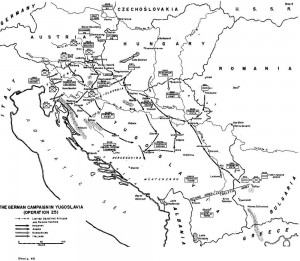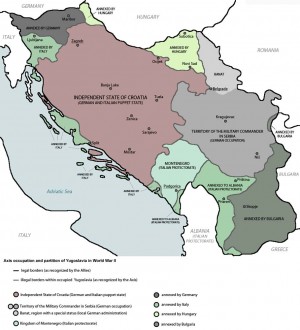 The invasion of Yugoslavia was an Axis mounted attack that took place during World War II. The invasion began on April 6, 1941, when the Germans launched a massive air assault on the Yugoslav capital, Belgrade. The primary aim of the air attack was to cripple the Yugoslav government, morale, air force, and anti-aircraft defenses. At the same time, German army units based in Bulgaria, which bordered Yugoslavia, commenced an attack from the southwest.
The invasion of Yugoslavia was an Axis mounted attack that took place during World War II. The invasion began on April 6, 1941, when the Germans launched a massive air assault on the Yugoslav capital, Belgrade. The primary aim of the air attack was to cripple the Yugoslav government, morale, air force, and anti-aircraft defenses. At the same time, German army units based in Bulgaria, which bordered Yugoslavia, commenced an attack from the southwest.
Yugoslavia had little hope of resisting the attack, primarily because the countries which formed all Yugoslavia’s land borders, namely Austria, Bulgaria, Romania, Hungary, and Italy, which also controlled Albania, had become part of the Axis. The Axis naval forces also had strategic control of the Adriatic Sea, Yugoslavia’s only coastline. In effect, Yugoslavia was completely surrounded, and surrendered in less than a fortnight on April 17.
Background
The Germans had tried to persuade Yugoslavia to join the Axis. The pressure to do so was greatly increased when Bulgaria, Romania, and Hungary joined, and in March of 1941, Yugoslavia’s prince regent and the government decided the country would join. Yugoslavia had a prince regent, because the heir to the throne, Prince Peter, was too young to assume power when his father was assassinated in 1934.
However, a large proportion of the population and the military opposed the move. The army replaced the prince regent with the constitutional heir, Peter, who was then 17. Hitler was incensed with this action and immediately began plans to attack Yugoslavia.
Hungarian Resistance
Even though Hungary had joined the Axis, it had also signed a peace treaty with Yugoslavia. Some of the Hungarian leadership was in favor of supporting Hitler’s invasion, but others felt Hungary should not breach its treaty with Yugoslavia. The Hungarian Prime Minister, Teleki, was aware that Hungary could do little to prevent the attack, but tried to ensure that no German or other Axis troops engaged in the invasion could move through Hungary. When he realized he could not succeed in this, he committed suicide rather than be a party to the invasion.
Miklos Horthy, Hungary’s regent, who had been in favor of taking part in the attack on Yugoslavia, declared that the treaty with that country would no longer be valid if the country no longer existed. When Croatia declared its independence from Yugoslavia, Horthy asserted that that scenario now existed, and ordered Hungarian troops to assist the Germans.
The Invasion
 The Germans launched their land invasion from Hungary on April 6. Hungarian troops moved into Yugoslavia a few days later. The Italians also launched an attack.
The Germans launched their land invasion from Hungary on April 6. Hungarian troops moved into Yugoslavia a few days later. The Italians also launched an attack.
Bulgaria did not lend any of its forces to the invasion, claiming it needed to use all of its armed forces to prevent attack from Greece. While Romania allowed its territory to be used, it did not send any of its forces to take part in the invasion.
In an effort to protect its air force, the Yugoslavs had decided to disperse the aircraft throughout the country, using small airfields as operations bases. However, the lack of facilities and resources at these fields, combined with adverse weather, seriously damaged the air force’s capabilities. The air force did manage to launch some bombing raids, and scored some successes in counter-attacking German bombing missions, but it was quickly overwhelmed. Recognizing imminent defeat, the Yugoslavs moved their remaining aircraft to Greece.
The blanket bombing of Belgrade had succeeded in severely disrupting Yugoslav communication, which greatly hampered the coordination of resistance operations. This may explain why Yugoslavia tried to resist the invasion on so many fronts instead of centralizing resistance in a smaller area, another factor in the speed at which the country succumbed.
Defensive Plan
Anticipating that the country might have to fight off an Axis invasion, the Yugoslavs had drawn up a plan of action. A key aspect of the plan was a retreat strategy. If the Yugoslav forces were to face impending defeat, it was decided that they should be in a position to drive through Albania, which was under Italian control, and join forces with the Greeks and other allies in the south.
This plan was put into action the day after the Axis invasion began, when a division of the Yugoslav army launched an assault into Albania. The attack commenced before all the Yugoslav forces were in position, and it had some initial successes. However, when it encountered German troops in the area of Prozren, the advance was halted.
Other divisions of the Yugoslav army launched attacks into Albania on separate fronts, and they too had some success. One of them managed to progress more than 30 miles into Albanian territory. The advances were halted by the increasing number of German reinforcements who were brought to Albania, and the Yugoslavs were soon locked in defensive actions, which quickly turned into retreat.
Yugoslav Navy
The Yugoslav Navy had available just 10 Motor Torpedo Boats (MTBs), two submarines, three destroyers, and a fleet of smaller boats useful only for inshore operations. At the start of the invasion, another destroyer was in dry dock at the fleet base in Kotor, which was very close to the border with Albania. The weapons on this ship were used in the defense of Kotor, and this represented the only meaningful contribution of the navy during the invasion.
The Yugoslavs had planned an attack on the Italian controlled port of Zadar, which would include a naval attack, and dispatched a destroyer and more than half its MTBs northwards in preparation for the attack. When one of the destroyer’s engines was put out of action following an air attack by the Italians, all the attack fleet returned to Kotor.
Consequences
 Casualties on both sides were relatively low, mainly because the invasion was completed in just 11 days. Most of the Yugoslav air force’s planes were lost during the conflict. The plan to unite retreating Yugoslav forces with the Allies in Greece was largely a failure. However, the Yugoslavs did manage to evacuate some aircraft and around 1,000 military personnel.
Casualties on both sides were relatively low, mainly because the invasion was completed in just 11 days. Most of the Yugoslav air force’s planes were lost during the conflict. The plan to unite retreating Yugoslav forces with the Allies in Greece was largely a failure. However, the Yugoslavs did manage to evacuate some aircraft and around 1,000 military personnel.
The fall of Yugoslavia paved the way for the German invasion of Greece, as all the countries on its northern borders were now under Axis control.